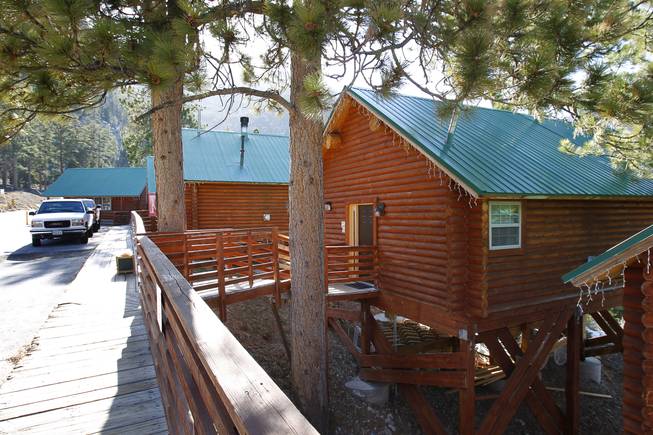Tuesday, July 9, 2013 | 2 a.m.
Related stories
- Officials estimate Mount Charleston wildfire won’t be contained until July 19
- For Mount Charleston evacuees, some answers about the nation’s top-priority wildfire
- In the wildfire trenches: 800 firefighters, on 12-hour shifts, fueled by 6,000 calories
- Crews keep Mount Charleston wildfire at bay, protecting every structure so far
- Mount Charleston called nation’s top wildfire priority; blaze is 15 percent contained
- 45 minutes and a world away: Mount Charleston residents relish life in high-altitude oasis
For residents of the 400 homes that make up the Mount Charleston community, forest fires like the one currently burning on more than 15,000 acres there are disasters that can be prepared for but not entirely protected against.
Homes are spread across three main areas on the mountain – Kyle Canyon, Lee Canyon and Trout Canyon – which each contain multiple housing subdivisions.
The fire, which has been burning on the mountain since it was started by a lightning strike July 1, threatens all 501 structures on the mountain, including the 400 homes, an elementary school, a library, several businesses and two fire stations.
Although there’s a constant threat of forest fires, residents and visitors are provided with guidelines through brochures and community awareness meetings to help prevent such fires.
The Clark County Fire Department and volunteer firefighters regularly stage community cleanups for pine needles, vegetation and other debris that could provide fuel for the flames.
Several dangerous actions, including building campfires outside of established areas, smoking except in enclosed vehicles, igniting fireworks or operating welding torches and other fire-generating devices without a permit are outlawed under state statute, with violators facing a $1,000 fine or up to six months in jail.
Homeowners are provided with further ways to reduce the threat and minimize damage from forest fires, including clearing leaves and other debris from gutters, porches and decks, removing flammable materials within 30 feet of a home or outbuilding, and pruning tree branches so the lowest are at least 6 feet above the ground.
Structures in the area also are subject to unique building codes not found elsewhere in the valley, although most deal with the snow and ice that is prevalent in the winter months. The only fire-related provision forbids the use of wooden roof shakes or shingles of any kind; instead, fire-resistant materials such as tile, asphalt or metal are recommended.
Residents in the area also pay more on their property taxes, about 88 cents per $100,000 of assessed value, to help fund the Mount Charleston Fire Protection District, which pays for services provided by the Nevada Division of Forestry fire station besides combating wildfires. Those services include responding to car accidents, medical incidents, and search-and-rescue cases.
Four Clark County fire engines, each manned by four firefighters, are assisting in the fight against the Mount Charleston fire, in part by clearing debris and moving patio furniture and other flammable materials away from structures to prevent the fire from spreading should it reach the community, Clark County spokesman Erik Pappa said. An additional 20 to 30 volunteer firefighters have also been assisting in the efforts, he said.
Most of the activity has been focused on Kyle Canyon, the most heavily populated and developed portion of the mountain that serves as the main entry point for most visitors to the area.
Homes in the area are broken down into four subdivisions – Rainbow Canyon, the first subdivision encountered on Kyle Canyon Road off U.S. 95; Old Town, the historic center of the community with buildings dating to the 1950s that include the school and library; Cathedral, a subdivision near Mount Charleston Lodge; and Echo Canyon, which includes homes on the ridge across the canyon from the lodge.
Homes range from 500 square feet to 10,000 square feet, and values stretch upwards of $1 million, topping out at $2.3 million, according to Angie Tomashowski, co-owner of Mount Charleston Realty.
Other areas affected by the fire include Lee Canyon, which has several homes surrounding the ski resort, and Trout Canyon, which has fewer than 30 homes in a community off Blue Diamond Road near Lovell Canyon on the way to Pahrump.


Join the Discussion:
Check this out for a full explanation of our conversion to the LiveFyre commenting system and instructions on how to sign up for an account.
Full comments policy